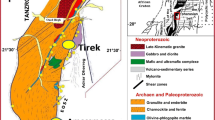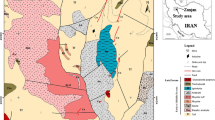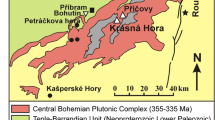Abstract
The gold lode in Fatira area is represented in three modes of occurrence: (1) altered felsite dykes, (2) massive quartz veins that are cutting through the hosting granitic rocks, and (3) siliceous-hybrid shear zone which is trending in NNW-SSE direction and separating between metavolcanic and granitic rocks. Metavolcanic rocks are described by meta-andesite and meta-dolerite varieties; they exhibit calc-alkaline magma type related to island arc system. However, granitic rocks are of I-type granodiorite composition with calc-alkaline affinity developed in convergent plate environment (island arc/active continental margins) during the late stage of orogeny. The wallrock alteration around the ore body includes propylitization, sericitization, and silicification facies. The ore minerals were observed as disseminated sulfides (pyrite, sphalerite, chalcopyrite, and covellite). Goethite, jarosite, and ilmenite are the main iron-rich mineral phase as well as malachite and rutile. Gold was detected by microprobe analysis within the internal composition of pyrite and/or jarosite. Two groups of fluid inclusions could be recognized in samples from different mineralized zones: (a) aqueous fluid inclusions (H2O–NaCl/KCl) and (b) aqueous-carbonic fluid inclusions (H2O–CO2–NaCl/KCl). Isochore construction from fluid inclusion data, combined with chlorite thermometry from alteration zone, revealed that Fatira gold deposits were formed at temperature range of 275–297 °C and pressure between 0.2 and 1.1 kb). The Fatira gold deposits exhibit similar features of both intrusion-related and orogenic deposits. Hence, the initial ore-bearing fluid was proposed to have originated from magmatic source at deeper levels related to the granitic emplacement (5–10 kb); moreover, the granitic batholith acted as an important vehicle for driving of the metamorphic hydrothermal currents and probably as a cause for the metamorphic process itself. Then, the migration of gold was taken place in form of bi-sulfide complexes and the final deposition occurred through fluid uplifting consequent with a possibility of mixing with meteoric water at shallow depths, pressure/temperature drop, and fluid/wallrock interactions.




















Similar content being viewed by others
References
Abd El Monsef M (2020) Ore controls and metallogenesis of Au-Ag deposits at Atalla Mine, Central Eastern Desert of Egypt. Acta Geol Sin (English Ed) 26. https://doi.org/10.1111/1755-6724.14326
Abd El Monsef M, Abdelnasser A (2020) Ore-forming mechanism and its relationship with deformational and metamorphic episodes at Haimur gold mine, Nubian Shield, Egypt. Geol Mag:1–19. https://doi.org/10.1017/S0016756820000655
Abd El Monsef M, Slobodník M, Salem IA (2018) Hydrothermal evolution of granitoid-hosted gold mineralization in gidami area: an example for orogenic-gold deposits in Egypt. J Afr Earth Sci 146:132–149
Abd El-Nabi HH (1977) Result of prospecting for mineral resources of Wadi Hammad, El-Atshan, El-Ghoza and Fatira El-Beida area. Internal report EGSMA, Technoexpert, Cairo
Abu-Alam T, Abd El Monsef M, Grosch E (2019) Shear-zone hosted gold mineralization of the Arabian–Nubian Shield: devolatilization processes across the greenschist–amphibolite-facies transition. Geol Soc Lond, Spec Publ 478(1):287–313
Anderson MR, Rankin AH, Spiro B (1992) Fluid mixing in the generation of mesothermal gold mineralisation in the Transvaal Sequence, Transvaal, South Africa. Eur J Mineral 4:933–948
Archibald CP, Shaw W, Leaman BM (1981) Growth and mortality estimates of rockfishes (Scorpaenidae) from BC coastal waters, 1977-1979. Department of Fisheries and Oceans, Resource Services Branch, Pacific Biological Station
Azzaz SA, Sabet AH, Soliman MM, Botros NS (1997) Mode of occurrence and genesis of the gold mineralizations in the North Eastern Desert of Egypt. Egypt Mineral 9:169–185
Bakker RJ (2003) Package FLUIDS 1. Computer programs for analysis of fluid inclusion data and for modelling bulk fluid properties. Chem Geol 194(1-3):3–23
Batchelor RA, Bowden P (1985) Petrogenetic interpretation of granitoid rock series using multicationic parameters. Chem Geol 48(1-4):43–55
Botros NS (1991) Geological and geochemical studies on some gold occurrences in the north Eastern Desert, Egypt. Unpublished Ph. D. Thesis, Zagazig University, 146.
Botros NS (1993) New prospects for gold mineralization in Egypt. Ann Geol Surv Egypt 19:47–56
Botros NS (2004) A new classification of the gold deposits of Egypt. Ore Geol Rev 25(1-2):1–37
Burruss RC (1981) Analysis of phase equilibrium in COHS fluid inclusions. Short course of fluid inclusions: application to ore petrology, 209-239
Cathelineau M (1988) Cation site occupancy in chlorites and illites as a function of temperature. Clay Miner 23(4):471–485
Cathelineau M, Nieva D (1985) A chlorite solid solution geothermometer the Los Azufres (Mexico) geothermal system. Contrib Mineral Petrol 91(3):235–244
Cox KG, Bell JD, Pankhurst RJ (1979) The interpretation of igneous rocks. Springer Science & Business Media, Allen and Unwin, London 450 pp
De la Roche H, Leterrier J, Grande Claude P, Marchal M (1980) A classification of volcanic and plutonic rocks using R1R2-diagram and major-element analyses—its relationships with current nomenclature. Chem Geol 29(1-4):183–210
El-Gaby S (1988) Geology, evolution and metallogenesis of the Pan-African belt in Egypt. The Pan-African Belt of the Northeast Africa and Adjacent Areas, 17-68
Floyd PA, Winchester JA (1975) Magma type and tectonic setting discrimination using immobile elements. Earth Planet Sci Lett 27(2):211–218
Fritz H, Abdelsalam M, Ali KA, Bingen B, Collins AS, Fowler AR, Ghebreab W, Hauzenberger CA, Johnson PR, Kusky TM, Mace P, Muhongo S, Stern RG, Viola G (2013) Orogen styles in the East African Orogen: a review of the Neoproterozoic to Cambrian tectonic evolution. J Afr Earth Sci 86:65–106
Gehrig M, Lentz H, Franck EU (1980) Phase-equilibria and P, V, T data ternary mixtures of water, carbon-dioxide and sodium-chloride up to 3 kbar and 550-degrees-C. In Chemie Ingenieur Technik. VCH Publishers INC, Deerfield Beach, FL 52:11:923-923
Goldfarb RJ, Baker T, Dubé B, Groves DI, Hart CJR, Gosselin P (2005) Distribution, character and genesis of gold deposits in metamorphic terranes. Soc Econ Geol. https://doi.org/10.5382/AV100.14
Groves DI, Goldfarb RJ, Gebre-Mariam M, Hagemann SG, Robert F (1998) Orogenic gold deposits: a proposed classification in the context of their crustal distribution and relationship to other gold deposit types. Ore Geol Rev 13(1-5):7–27
Guilbert J, Park C (1986) The geology of ore deposits. W.H. Freeman and Co., New York 985 p
Haroun RG (2001) Metallogenic studies on Wadi Fatira area, Eastern Desert, Egypt. M. Sc. thesis, Ain Shams University. 289 pp
Hart CJR, Goldfarb RJ (2005) Distinguishing intrusion-related from orogenic gold systems. In New Zealand Minerals Conference Proceedings, 125-133
Hey MH (1954) A new review of the chlorites. Mineral Mag J Mineral Soc 30(224):277–292
Hillier S, Velde B (1991) Octahedral occupancy and the chemical composition of diagenetic (low-temperature) chlorites. Clay Miner 26(2):149–168
Hollister LS, Burruss RC (1976) Phase equilibria in fluid inclusions from the Khtada Lake metamorphic complex. Geochim Cosmochim Acta 40(2):163–175
Hussein AA, Aly MM, El Ramly MF (1982) A proposed new classification of the granites of Egypt. J Volcanol Geotherm Res 14:187–198
Irvine TNJ, Baragar WRA (1971) A guide to the chemical classification of the common volcanic rocks. Canadian journal of earth sciences 8(5):523–548
Jahren JS, Aagaard P (1989) Compositional variations in diagenetic chlorites and illites, and relationships with formation-water chemistry. Clay Miner 24(2):157–170
Kesler SE (2005) Ore-forming fluids. Elements 1(1):13–18
Klemm DD, Klemm R, Murr A (2001) Gold of the Pharaohs–6000 years of gold mining in Egypt and Nubia. J Afr Earth Sci 33(3-4):643–659
Kranidiotis P, MacLean WH (1987) Systematics of chlorite alteration at the Phelps Dodge massive sulfide deposit, Matagami, Quebec. Econ Geol 82(7):1898–1911
Kröner A, Stern RJ (2004) Pan-African Orogeny. Encyclopedia Geol, Elsevier, Amsterdam 1:1–12
Lebas MJ, Lemaitre RW, Streckeisen A, Zanettin B (1986) A chemical classification of volcanic-rocks based on the total alkali silica diagram. J Petrol 27(3):745–750
Liew T, Finger F, Hock V (1989) The Moldanubian granitoid plutons of Austria: chemical and isotopic studies bearing on their environmental setting. Chem Geol 76(1-2):41–55
Lundmark AM, Andresen A, Hassan MA, Augland LE, Abu El-Ru MA, Boghdady GY (2012) Repeated magmatic pulses in the East African Orogen of Central Eastern Desert, Egypt: an old idea supported by new evidence. Gondwana Res 22:227–237
Luth WC, Jahns RH, Tuttle OF (1964) The granite system at pressures of 4 to 10 kilobars. J Geophys Res 69(4):759–773
Maniar PD, Piccoli PM (1989) Tectonic discrimination of granitoids. Geol Soc Am Bull 101(5):635–643
McCuaig TC, Kerrich R (1998) P—T—t—deformation—fluid characteristics of lode gold deposits: evidence from alteration systematics. Ore Geol Rev 12(6):381–453
McDowell SD, Elders WA (1980) Authigenic layer silicate minerals in borehole Elmore 1, Salton Sea geothermal field, California, USA. Contrib Mineral Petrol 74(3):293–310
Mériaud N, Jébrak M (2017) From intrusion-related to orogenic mineralization: the Wasamac deposit, Abitibi Greenstone Belt, Canada. Ore Geol Rev 84:289–308
Murr A (1999) Genese der Goldlagerstättenbezirke Fatira, Gidami, Atalla und Hangaliya in der Ägyptischen Ostwüste. Inst. für Allg. u. Angewandte Geologie d. Ludwig-Maximilians-Univ, p 203
Noweir AM, Sewifi BM, Abu El-Ela AM (1990) Geology, petrography, geochemistry and petrogenesis of the Egyptian Younger Granites. Qatar University. Sci Bull 10:363–393
Pearce JA, Gall GH (1977) Identification of ore-deposition environment from trace-element geochemistry of associated igneous host rocks. Geol Soc, London, Special Publications 7(1):14–24
Pearce TH, Gorman BE, Birkett TC (1977) The relationship between major element chemistry and tectonic environment of basic and intermediate volcanic rocks. Earth Planet Sci Lett 36(1):121–132
Phillips GN, Powell R (2010) Formation of gold deposits: a metamorphic devolatilization model. J Metamorph Geol 28(6):689–718
Pichavant M, Ramboz C, Weisbrod A (1982) Fluid immiscibility in natural processes: use and misuse of fluid inclusion data: I. Phase equilibria analysis—a theoretical and geometrical approach. Chem Geol 37(1-2):1–27
Roedder E (1984)Fluid inclusions (Review in Mineralalogy, vol. 12). Mineralogical Society of America, Washington, DC, p 646
Roser BP, Korsch RJ (1986) Determination of tectonic setting sandstone-mudstone suites using SiO2 content and K2O/Na2O ratio. J Geol 94(5):635–650
Sabet AH, Tosgeov VB, Bordonosov VP, Baburin LM, Zalata A (1976) On gold mineralization in the Eastern Desert of Egypt. Ann Geol Surv Egypt 6:201–212
Seward TM (1984)The transport and deposition of gold in hydrothermal systems. In Gold 82: the geology, geochemistry and genesis of gold deposits. Symposium (pp. 165–181)
Shenberger DM, Barnes HL (1989) Solubility of gold in aqueous sulfide solutions from 150 to 350 C. Geochim Cosmochim Acta 53(2):269–278
Sillitoe RH (1991) Intrusion-related gold deposits. In Gold metallogeny and exploration. Springer, Boston, MA, 165–209
Spencer RJ, Møller N, Weare JH (1990) The prediction of mineral solubilities in natural waters: a chemical equilibrium model for the Na▪ K▪ Ca▪ Mg▪ Cl▪ SO4▪ H2O system at temperatures below 25° C. Geochim Cosmochim Acta 54(3):575–590
Stern RJ (1994) Arc assembly and continental collision in the Neoproterozoic East African orogen: implications for the consolidation of Gondwanaland. Annu Rev Earth Planet Sci 22:319–351
Stern RJ, Gottfried D, Hedge CE (1984) Late Precambrian rifting and crustal evolution in the North Eastern Desert of Egypt. Geology 12:168–172
Sun SS, McDonough WF (1989) Chemical and isotopic systematics of oceanic basalts: implications for mantle composition and processes. Geol Soc, London, Special Publications 42(1):313–345
Surour AA, Attawiya MY, Hussein HA, El-Feky MG (1999) Shear zone microfabrics and multiple source of gold at the Hangaliya Mine, Eastern Desert, Egypt. Egypt J Geol 43(1):39–52
Swanenberg HEC (1979) Phase equilibria in carbonic systems, and their application to freezing studies of fluid inclusions. Contrib Mineral Petrol 68(3):303–306
Tuttle OF, Bowen NL (1958) Origin of granite in the light of experimental studies in the system NaAlSi3O8–KAlSi3O8–SiO2–H2O. Geol Soc Am Mem 74, 153 p
White AJR, Chappell BW (1983) Granitoid types and their distribution in the Lachlan Fold Belt, southeastern Australia. Geol Soc Am Memoir 159(12):21–34
Wilson M (2007) Igneous petrogenesis a global tectonic approach. Springer Science & Business Media, Springer, p 466
Wright GB (1969) A simple alkalinity ratio and its application to questions of non-orogenic granite genesis. Geol Mag 106(4):370–384
Xavier RP, Foster RP (1999) Fluid evolution and chemical controls in the Fazenda Maria Preta (FMP) gold deposit, Rio Itapicuru greenstone belt, Bahia, Brazil. Chem Geol 154(1-4):133–154
Zalata AA, Ghobrial GA, Abu Ellil I (1972) The geology of the basement rocks at the south west of El-Shayib and North West of Bir Umm Fawakhir sheets, Eastern Desert. Geological Survey of Egypt, International report No.15/72
Zhang X, Nesbitt BE, Muehlenbachs K (1989) Gold mineralization in the Okanagan Valley, southern British Columbia; fluid inclusion and stable isotope studies. Econ Geol 84(2):410–424
Zhang X, Zhang H, Tang Y, Wilde AA, Hu Z (2008) Geochemistry of Permian bimodal volcanic rocks from central Inner Mongolia, North China: implication for tectonic setting and Phanerozoic continental growth in Central Asian Orogenic Belt. Chem Geol 249(3-4):262–281
Zoheir BA, Akawy A, Hassan I (2008) Role of fluid mixing and wallrock sulfidation in gold mineralization at the Semna mine area, central Eastern Desert of Egypt: evidence from hydrothermal alteration, fluid inclusions and stable isotope data. Ore Geol Rev 34(4):580–596
Author information
Authors and Affiliations
Corresponding author
Additional information
This article is part of the Topical Collection on Current Advances in Geological Research of Egypt
Electronic supplementary material
ESM 1
(XLSX 17 kb)
Rights and permissions
About this article
Cite this article
Abd El Monsef, M., Slobodník, M. & Salem, I.A. Characteristics and nature of gold-bearing fluids in Fatira area, North Eastern Desert of Egypt: possible transition from intrusion-related to orogenic deposits. Arab J Geosci 13, 1034 (2020). https://doi.org/10.1007/s12517-020-05982-8
Received:
Accepted:
Published:
DOI: https://doi.org/10.1007/s12517-020-05982-8




